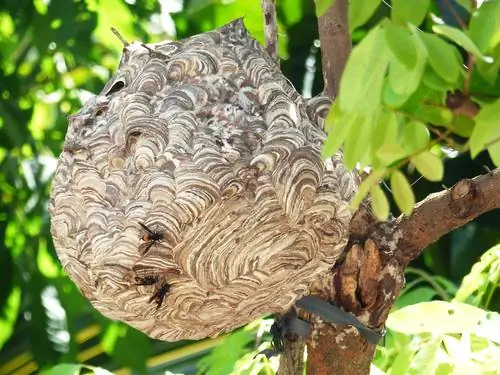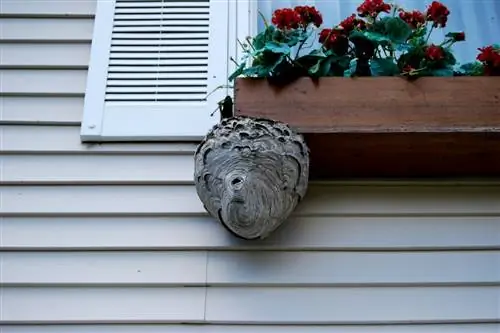- Author admin [email protected].
- Public 2023-12-26 14:17.
- Last modified 2025-01-23 11:19.
A hornet's nest in the garden or in the house can become a problem. The large wasps occasionally settle in homes or gardens, where they can make some people uncomfortable. In order to deal with animals properly, you should know a few things about them.
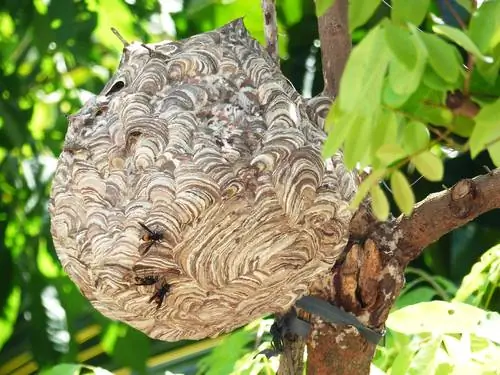
What to do against annoying hornets?
If the hornets in your living area really bother you, you should use gentle defense methods. Aggressive mallet methods are generally out of place with potentially dangerous animals that are not easily controlled. Unfortunately, a certain degree of tolerance is always required. The art of properly defending against hornets is a balancing act between caution and forbearance. Justifiable yet reasonably effective measures include the following:
- Save off the area around the hornet's nest
- Counter it with smells
- Have the nest professionally relocated
If you can somehow avoid the area around the hornet's nest for a while, simply cordon off it with tracing tape or other material. In this way you prevent visitors, children and yourself from carelessly venturing into the immediate vicinity of the nest. This can really promote peaceful coexistence.
You cannot use certain smells to drive hornets away from an established nest, but you can prevent them from building a nest if necessary. It may be worthwhile to emit certain odors in places that hornets might consider suitable for living and breeding. What the animals are sensitive to are the ethereal and citrusy scents of lemons, lavender or cloves, as well as garlic or hairspray.
The safest method is to have the nest relocated by a professional. We want to go into this in more detail in the following section.
Remove hornet nest
Legal restrictions
Why it is so important to accurately identify the wasp species before attacking a nest has to do with animal protection law. Anyone who feels disturbed or threatened by insects is not always allowed to act against them as they see fit. This is especially true for hornets. As an endangered species, they enjoy special protection under the Federal Nature Conservation Act, according to which catching, damaging or killing the animals is strictly punishable. Violation can result in hefty five-figure fines.
The species protection restriction is, however, accompanied by the additional note “without reasonable reason”. A somewhat vague expression, but it must always be assessed in each individual case whether such a reasonable reason exists. What often speaks in favor of removing a hornet's nest are small children living in the household or people who are allergic to insect venom. In such cases, professional removal or relocation of the nest may be permitted by the local conservation authority.
However, if the threat is not really acute, you should always try to come to terms with the hornet's nest first. In general, they are peaceful animals that only sting when they feel threatened. In addition, unlike German and common wasps, they are not as aggressive about our outdoor meals. The lifespan of a hornet colony is also limited: the cycles are annual and the animals' activity is limited to the summer months. So you can always keep in mind that the stress will soon stop on its own anyway.
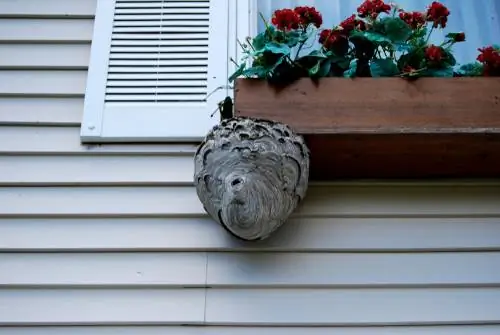
A hornet's nest should always be removed by a professional
The professional nest relocation or removal
Before initiating nest removal, you must take the following steps:
- Obtain permission from the local nature conservation authority
- Instruct a specialist (not the fire department)
- Calculate costs
You should always have a hornet's nest removed by professionals. Because you need a lot of experience to safely handle these large stinging insects. Anyone who attempts to relocate on their own exposes themselves to an incalculable danger and may then violate species protection laws in self-defense mode.
The relocation of a hornet's nest can, for example, be carried out by a beekeeper or an employee of a nature conservation association. The fire department has no longer been responsible for removing insect nests for some time.
Relocation is best carried out in a phase in which the animals are in rest mode anyway. Daily periods of rest or cold periods in summer are beneficial.
The animals are then put into a state of twilight using an animal-friendly agent so that they and the nest relocation professional do not come under unnecessary stress. The nest is then carefully removed from its niche, placed in a container and rebuilt at least 3 to 4 kilometers away. From this distance the animals can no longer find their way back to their original place of work.
Costs
Of course the whole thing isn't free. How much money you have to invest in professional hornet nest removal varies. Any relocation measure depends on several situational factors. These include:
- Nest size
- Accessibility of the nesting site
- Effort of removal without damage
- Time expenditure
If the hornet's nest is in a place that is difficult to reach, such as a cavity in the roof or in the roller shutter box, it can take a lot of time to gain access. The way the hornets have fortified their housing can also make the professional sweat. Depending on how big the nest is, more anesthetic is needed.
All of these factors can increase the duration of use and therefore the costs. You can expect to spendaround 100 eurosif you hire someone from a nature conservation organization,private experts are a little more expensive at around 150 to 350 euros. Anyone who lives in a rented apartment can get away for free: the cost of removing insect nests is usually borne by the landlord. However, a hornet settlement is not a reason for a rent reduction. Precedent cases involving wasp nests have shown that the settlement of insect nests is classified by courts as a natural fact that must be accepted.
Remove empty hornet nest
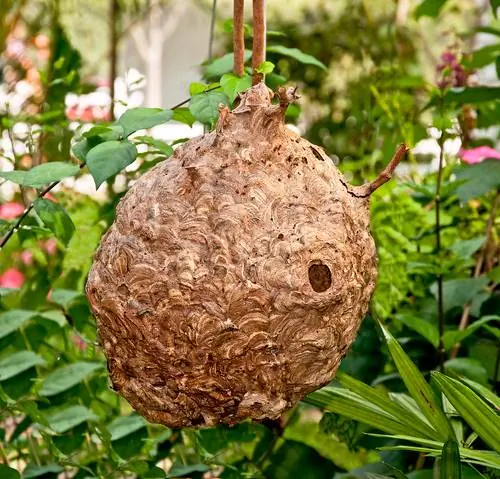
Once the nest is abandoned, it can be easily removed - or converted into a decorative element
In autumn the hornet state dissolves. The majority of the members, i.e. the workers and the drones, have now completed their task and simply die off according to the sober laws of nature. Only the fertilized young queens, who are responsible for maintaining the species, continue to live and overwinter. To do this, they individually look for a sheltered place, such as underground cavities or cracks in dead wood, where they fall into hibernation. So the nest becomes orphaned towards winter.
You don't have to worry that the young queens will settle their own new colony in the old nest structure after overwintering. Each queen begins to build her own nest in the spring to establish her own colony, usually in a different location.
Nevertheless, the abandoned nest can of course be disturbing. Reasons for having to remove an old hornet nest include the following:
- Elements in the house are affected (for example the roller shutter if it sits in the roller shutter box)
- Smell created
- Prevention of other animals settling in the nest
Impairment of residential elements
If you keep hitting your head on the old hornet's nest in the attic or garden shed, it obviously makes sense to remove it. Functional elements in the home can also be affected by the nest and require removal. The classic is a nest in the roller shutter box that blocks the roller shutter. If you can avoid lowering the shutters over the summer, you should do so and only remove the nest once it has been orphaned. This will save you and the animals from unpleasant collisions.
Developing smell
You may also be forced to remove the orphaned nest due to the stench that arises. Especially in the final stage, a hornet's nest can develop an unpleasant, sweet-biting smell - this is due to the cloaca on the underside through which the animals drop their feces and underdeveloped, killed larvae. There the material rots and begins to smell. Not a nice thing if the nest is in or on the house. If the smell becomes too unbearable while the nest is still inhabited, you can help yourself by laying out newspaper or crepe paper under the nest and replacing it again and again.
When the hornet's nest is repopulated
The hornets themselves no longer move into their old homes, but other small animals are happy to accept them as shelter. So that you don't soon get new crawling and messy tenants when the breeding site is deserted, you should remove the nest in winter.
Other handling of hornets
If you can somehow tolerate the hornets in the garden shed, in the attic or in the tree, you should avoid fighting them if possible. Because this may only cause you and the animals more stress and discomfort.
An inner attitude in which one sees the settlement of animals as a completely natural occurrence can have a big impact. It is helpful to consider the positive and useful properties of hornets. Because they have some of them:
- Decimate pest insects
- Stay away from our garden tables
- They are an important link in the ecosystem
- Are a rarity
Decimation of insect pests
Hornets feed a lot of insects to their larvae that affect garden culture or our well-being - such as mosquitoes, moth caterpillars, beetles, flies and other wasps.
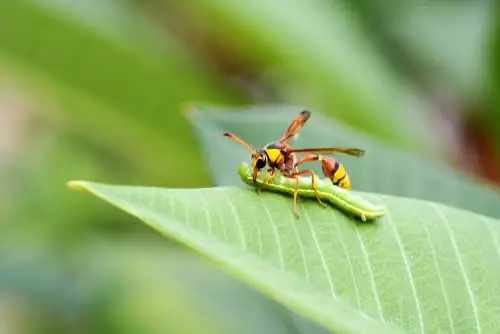
Hornets eat pests
Stay away from our garden tables
It is very pleasant that they are not at all interested in cakes, ice cream, cold cuts and open jars of jam on our garden tables. In general, they behave much more reservedly compared to German wasps and common wasps (which most people also know as typical wasps because of their offensive nature). If they are not disturbed or harassed, they are extremely peaceful, almost even tame!
Important role in the ecosystem
Of course, hornets also play an essential role in the general ecological balance. Through their hunting activity, they contribute to the balance of the species and their role as flower pollinators should not be underestimated. After all, insects only hunt hornets for their larvae, which need protein-rich food to grow up. The adult animals, on the other hand, eat a vegetarian diet: pollen, honeydew and carbohydrate-rich plant juices.
Hornets are rare
It is not for nothing that hornets enjoy special protection under the Federal Nature Conservation Act. Their species has been declining for some time - an alarming situation given the general decline in species. Due to the lack of suitable habitat, hornets are increasingly dependent on refuges close to people. Therefore, consider yourself lucky if hornets seek asylum in your home! With them you get rare and therefore valuable subtenants worth protecting, which are a sign of hope for regenerating stocks.
“Hornets are threatened with extinction in many regions of Central Europe.”
What to avoid when dealing with hornets
We now know why hornets are so worth protecting. In order to implement the necessary respectful treatment of them, you should know what you should avoid when dealing with them. The NoGos not only serve the safety of the animals, but of course also your own.
Hornets are not inherently aggressive, but when it comes to nest defense, they can certainly be defensive. What excites hornets unnecessarily are the following things:
- Noise near the nest
- Violent, hectic movements near the nest
Noise can upset not only human neighbors, but also animal neighbors. Hornets are actually quite irritable about this. Loud engine noise from equipment used in the house or garden such as lawn mowers, chainsaws or drills can be very annoying to the hornets.
But the animals also see noises that are specifically made to scare them away, such as banging on the roof of nests in the attic, as an attack - which is actually correct. Through such activities you can literally attract the large insects to you. In addition - we remember - not only catching and killing, but also intentional damage falls under the acts prohibited by species protection law.
You should also avoid violent movements in the immediate vicinity of the nest. Because this can also put the hornets into defense and attack mode. In this they are no different from other social wasps.
Background
How does a hornet's nest form?
In general, all true wasps build their nests in a similar way. The architecture of the buildings is also similar to bee hives: in principle, honeycomb-shaped chambers form the core of the nest, which is protected by an outer shell. This creates a more or less spherical structure. The honeycombs serve as breeding cells for the larvae.
Hornet queens begin their nest building like other real wasps by creating the first honeycomb chambers in which they lay their first eggs. The brood cells are oriented vertically, hanging downwards. As a material, hornets use wood fibers, which they gnaw from rotten branches or wood affected by white or brown rot, chew and mix with their saliva to make a viscous paste. This means that the finished structure will later appear very paper-like.
While the first larvae are developing, the hornet queen is already building the outer shell. For this she uses the same wood-saliva pulp as for the brood cells. The protective cover is created from hollow pockets - so hornets understand the principle of air insulation quite intuitively. The enclosed air layers effectively protect the inside of the nest from greater temperature fluctuations.

As soon as the first workers have hatched, the nest building work for the queen is complete. The workers are now responsible for continuing the construction work, while the queen now concentrates exclusively on laying eggs. The workers start where the queen left off and continue according to the same principle: more and more brood chambers are created in horizontal plates one below the other and the outer shell continues accordingly.
Finally, a hornet's nest can reach around 60 cm in diameter, making it smaller than the largest nests of German or common wasps. A colony of hornets only has around 400 to 700 animals, while colonies of German or common wasps can contain up to 7,000 individuals.
Hornets versus German and common wasps
If you are dealing with a balloon-like nest structure that appears to be made of paper, it is almost certainly a nest of real wasps. Both the animals in this subfamily and the species-specific nests only differ in relatively fine details. However, the differentiation is anything but insignificant - because if the wasps bother you and you want to do something about them, you must observe animal welfare restrictions.
Identifying a hornet's nest
You can tell from certain features whether you are standing in front of a hornet's nest or a wasp's nest of another species. If you collect as many impressions as possible, you can arrive at a relatively reliable diagnosis. Here is a brief overview of the identifying features of the animals to be observed and the nests:
| Hornets | German/Common Wasps | |
|---|---|---|
| Identification features of animals | Larger body shape: workers 18 to 25 mm long, drones 21 to 28 mm long, queens 23 to 35 mm long | Smaller body shape: workers 11 to 16 mm long, drones 13 to 17 mm long, queens up to 20 mm long |
| Coloring: middle trunk segment black to brown or brick red without yellow elements, only the abdomen shows characteristic black and yellow markings | Coloring: completely black-yellow (warning) drawing | |
| Identification features of the nests | Slightly smaller size (due to smaller state size): maximum length of up to 60 cm, filled-looking, light brown shell around horizontal honeycomb plates, lower opening used for excretions | More greyish, roundish nests up to the size of a football |
| Location: especially rain-protected places in and around the house, in garden sheds, in the forks of trees | Prefers dark, sheltered places in and around the house or in garden sheds, but occasionally also in the ground! | |
| Sounds: Humming also at night because hornets are nocturnal, during the day scratching and trampling from begging larvae and incoming and outgoing workers | Humming and larval noises only during the day |
At first glance you can recognize a hornet's nest or wasp's nest primarily by its size and color. If it is rather small, despite relatively large animals flying in and out, you are probably dealing with a colony of hornets. Nocturnal humming is also a clear sign that it is a hornet's nest.
Excursus
Wasps in the soil
If you have a colony of yellow-striped stinging insects living in your garden soil, you can rule out the possibility that they are hornets. They only nest above ground, preferably at higher altitudes.
Only common and German wasps occasionally nest in underground nesting sites, such as in abandoned mouse or mole burrows. Apart from that, of course, there are also numerous other species of wasps, which, however, differ significantly from hornets, German and common wasps due to their smaller size and different coloring. In addition, most of them live solitary lives, i.e. not in large groups of states, but alone with their brood.
Frequently asked questions
Do certain home remedies help against hornets?
Home remedies that are often promoted unfortunately usually help little or not at all. Certain smells can irritate the animals minimally, but they cannot drive away an established colony. Some home remedy barriers are actually nothing more than superstition, such as coffee or copper coins. The method of hornet nest dummies, which are intended to exploit the animals' territorial behavior, is also questionable: by simulating an unfamiliar nest, flying animals are supposed to flee. However, many practical experiences show that this method is not effective.
Can you remove a hornet's nest yourself?
Of course you can remove an abandoned hornet nest. That is their right. What you should never do, however, is destroy a nest that is still inhabited on your own, for example by flushing it out or fumigation. In doing so, you are not only violating the Endangered Species Act, but you are also putting yourself at great risk.
Are hornets particularly dangerous?
Probably simply because of their size, hornets still have a reputation for being particularly dangerous. Their stinging venom is no more toxic than that of other wasps or bees and does not cause any unusually strong reactions, except in people allergic to insect venom and children. Due to a different composition of the hornet sting venom and the generally smaller amount injected, hornet stings are even smaller and involve less swelling than stings from other wasps or bees.

